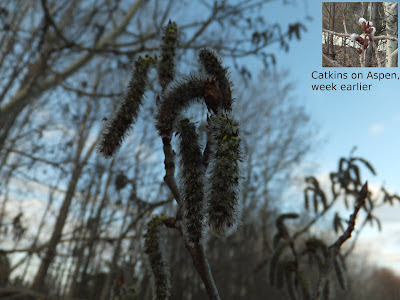
The weather turned seasonally cool this past week after an unprecedented March heatwave the week before where temperatures reached the high 20s for several days. The warm weather gave all the trees a tremendous head start on spring. Above is a picture of a trembling aspen covered in catkins taken last Sunday.
There are a couple of dozen small Aspen saplings sprouting up in the 2010 naturalization area on the west side of the crab apples. They sprout up from the roots of the neighbouring trees and can grow 4 feet in a season. The saplings that made a start in 2010 are already about 8 feet high. They will soon provide some shade for the maples planted there. Aspens are a natural pioneer tree species that grow quickly but do not tolerate shade. They help other more shade tolerant trees get established though by creating the forest ecosystem conditions that allow other species to thrive. The sunny meadow-like conditions of the naturalization areas is an ideal setting for aspens but not so ideal for many of the species such as the maples we planted there. The maples would have preferred a forest soil of thick rotting humus with partial shade where they didn't have to compete with grasses and vetches and where there weren't quite so many hungry voles looking for a nice snack to carry them through the winter.
Below is a picture of one of the trunks of the aspen saplings where some galls have formed. These galls are likely due to the poplar twiggal fly The galls don't seem to hurt the tree and I don't want to damage the tree by cutting into one of the galls. Aspens are susceptible to a number of cankers that may get their start where a tree is wounded.

No comments:
Post a Comment